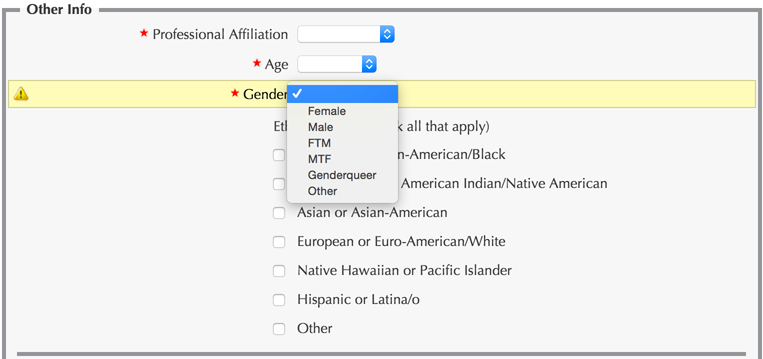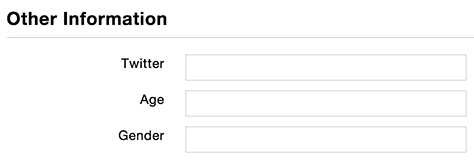On Forms and Personal Information
I am deeply frustrated right now. Yet again, a tech organization has failed horribly at requesting gender information. Their attempts to "fix" it are not an improvement. It's troubling how frequently this happens. It seems like organizations aren't learning. This is my attempt at turning my frustration into education.
Disclaimer: I am not an expert on any of this. I strongly recommend consulting people from impacted groups for feedback.
Requesting personal information
Are you an organization that requests personal information from people? Maybe you run a conference and want attendee information. Maybe you develop software and want to learn about your users. Whatever your use case, asking for personal information should be done thoughtfully.
Being thoughtful should include asking a lot of questions:
- What information do you want?
- Why do you want this information?
- What information is required? Why?
- How will you format requests for information?
- How will you communicate requests for information?
- How will requests impact the people you are asking?
- How will this information be stored? Who will have access to it? Is it secure?
Let's break each of these down and talk about why they are important.
What information do you want?
Start by making a list of personal information that you want to request from people. You need this for the other questions.
Why do you want this information?
Evaluate why you want each piece of personal information. If you cannot come up with a good reason, you should not be asking for it.
What information is required? Why?
For each piece of personal information, evaluate if it should be required or optional. If you cannot come up with a compelling reason for it to be required, it should be optional.
How will you format requests for information?
For each piece of personal information, consider how you will format a request for that information. Will you give the person a text box or a list of options to choose from? If the latter, how will you populate that list?
Many organizations prefer to use a list of options because it allows for information to be formatted in a uniform way. However, lists are a common source of problems. This post was prompted by an organization failing when requesting gender information by using a list.
An open text box requires more work to aggregate information, but it often provides a better user experience. If you do not have the time to aggregate the information, really think about if you should be requesting it in the first place.
Carina C. Zona's excellent talk, "Schemas for the Real World," discusses this and provides some great examples. I recommend giving the talk and slides a look if you want to learn more.
How will you communicate requests for information?
How will you communicate to people why you are requesting this information and what it will be used for? Personal information is important to many people, and they want to understand why you want it and how it will be used. Thoughtful communication not only informs people, but can assuage worries about privacy or even make them feel good about your organization.
How will requests impact the people you are asking?
Think about how your requests will impact people. Consult with people from impacted groups to test things out and get feedback. You should care about this. It is a part of the user experience for your event, product, etc.
Some requests can lead to a negative response. Will requiring private personal information make them less likely to use your product? Will a poorly constructed list make someone feel unwelcome at your event?
Some requests can lead to a positive response. Will asking people about their dietary needs make them feel welcome at your event? Will providing an open text box for personal information make people excited about your product because they can express themselves accurately?
How will this information be stored? Who will have access to it? Is it secure?
For each piece of of personal information, evaluate if it is personally identifiable information (PII). PII has security (and sometimes legal) implications. I am not an information security expert or a lawyer, so I am not qualified to expand on these implications. If you are asking people for PII, you should consult with experts about these issues.
Gender
Gender is the piece of personal information I most frequently see organizations get wrong. One such failure prompted this post, so I want to expand on this.
Many organizations request gender information when it is not needed. Sometimes out of laziness. Sometimes out of habit. Really think about why you are requesting gender information. If you don't have a compelling reason, don't ask for it.
Assuming you have a legitimate reason to request gender information, you need to be thoughtful about how you do so.
Let's start at the beginning. Gender is not binary. If you give two options: male and female, you are doing it wrong. Let me repeat. GENDER IS NOT BINARY.
Some organizations want to indicate they are inclusive of transgender people and try to do so in their gender form. This often goes terribly wrong. For example, look at Grace Hopper Celebration 2015's registration form below.

Original gender input for Grace Hopper Celebration's registration.
They get a point for understanding that gender is not binary, but fail pretty badly by including "MTF" (male to female) and "FTM" (female to male) in a narrow set of options. While some transgender people prefer to identify this way, many would find this a frustrating and upsetting choice to make. For example, a transgender woman is a woman and would likely want to select the female option in the dropdown.
After receiving criticism about this, they modified the form as seen below.

Modified gender input for Grace Hopper Celebration's registration.
This version of the form is about as bad as the previous one. While some transgender people may be ok with this, many are not and find it problematic. This form makes them choose between their gender (e.g. female for a transgender woman) and sharing the information that they are transgender. Most people use transgender as an adjective or modifier, not as their gender. I am a cisgender woman. Some of my friends are transgender women. We are all women working in tech, and we find this gender dropdown unacceptable.
Both iterations of the form can make people feel obligated to disclose that they are transgender. For many, this is information that they do not want to disclose for a wide variety of reasons including privacy and safety. This requirement may upset people and make them feel unwelcome or unsafe at an event. The organization's interest in obtaining this demographic information should not trump the comfort and safety of potential attendees.
How do you handle the complexities of gender and make sure you do the right thing? Use a text box! Below is an example of the gender input on the registration form for Open Source Bridge 2015. They also make it optional, so that people are not obligated to share this private information.

Gender input for Open Source Bridge's registration.
Why are you picking on Grace Hopper Celebration?
Here I am, yet again, writing a blog post about how Grace Hopper Celebration has failed. I'm not happy about it, but they leave me little choice. I expect more from an event that bills itself as "the World's Largest Gathering of Women Technologists." An event run by the Anita Borg Institute, a prominent organization with a budget of several million dollars. I am not picking on them. I am trying to hold them accountable. As a member of the demographic they supposedly serve, I expect more.
As a note, they published an explanation and apology about what happened, but I find it lacking. I expect more.
We recognize that a write-in box for gender identity that allows participants to simply mark their own gender identity is the optimal solution, but are currently unable to provide this service given our current resources.
Conclusion
Please be thoughtful when your organization requests personal information from people. Ask a lot of questions. Only require information that is critical. Be thoughtful about how you ask for information. Communicate why you want the information. Empathize with the people you are asking. Get feedback before you move forward on a path that may end badly. Make sure you have the resources available to address problems and make changes in the case that you make a mistake.